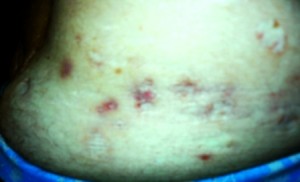Hidradenitis Suppurativa (Verneuil’s Disease)
Dr Christophe Hsu – dermatologist. Geneva, Switzerland
How frequent is it ?
- It affects 1% of the population with a peak of 3-4 % in the 11 to 30 years old age group.
- Females are affected 3 times more than males. (controversial as some studies report no difference)
How does it present ?
- It presents as nodules (abscesses, sinuses) in the skin folds (groin and axilla) with redness (inflammation) and discharging of a clear foul smelling liquid. (The diagnosis is clinical)
- This chronic symptomatology is psychologically devastating and may lead to feelings of rejection and subsequent depression.
- The disease displays several forms of severity (The passage from one type to the other is possible but rare):
- Benign forms: intermittent with prolonged remissions.
- Minor to moderate forms: continuous or semicontinuous forms.
- Severe forms.
Are other conditions associated with it ?
- It is part of the follicular occlusion tetrad (acne inversa or follicular occlusion syndrome). It is simplistic but groups conditions which have common grounds in their development:
- Ectopic “acne-like lesions” (previously incorrectly termed as acne conglobata): these are lesions which in fact are typical of Verneuil’s disease presenting in atypical areas.
- Dissecting cellulitis of the scalp (perifolliculitis capitis abscedens et suffodiens or Hoffman’s Disease): presents clinically as severe inflammation and scarring on the scalp.
- Pilonodal sinuses of the buttock region.
What is the cause ?
- The exact inital cause is unknown and international experts often disagree. Familial forms seem to exist.
- It is a disease which affects the opening of the hair follicle on the surface of the skin. Keratin accumulates at this place, which contributes to the occlusion of the hair follicle on the surface of the skin. The retention of bacteria and the discharging of liquid extends then to the surrounding apocrine glands.
- The space containing the hair follicle and the surrounding dermis becomes inflamed which leads to abscess formation and a liquid discharge.
- Apocrine glands participate normally to defend the region of the follicle against infections by secreting antimicrobial substances. In Hidradenitis Suppurativa, there seems to have a decreased immunity and thus resistance to infection. This is either within the gland or its opening into the hair follicle.
- The exact causes are still speculative and one hypothesis is shown here: an Endocrinological disease (Often female are more affected, begins during puberty, ends at the menopause, worsens before periods, improves during pregnancy. BUT blood androgen levels remain normal anti antiandrogens are ineffective).
How is it treated?
The treatment must be adapted to each individual case. Weight reduction and to stop smoking can improve the condition.
- In milder cases local antiseptics and antibiotics and oral antibiotics can control the symptoms.
- In severe cases, surgical excision of the apocrine glans in the axilla and groin are the only solution.
- More recently there is the clinical application of the biologics. These act by inhibiting mediators of inflammation (TNF-a (Tumor Necrosis Factor).
- Vitamin A analogues are widely used and some (such as acitretin) are showing promising results. Isotretinoin, however doesn’t appear to be effective.
References:
- Absence of efficacy of oral isotretinoin in hidradenitis suppurativa: a retrospective study based on patients’ outcome assessment. Soria A, Canoui-Poitrine F, Wolkenstein P, Poli F, Gabison G, Pouget F, Viallette C, Revuz J. Dermatology. 2009;218(2):134-5.
- Dermatologie et infections sexuellement transmissibles, 5th edition
- Dr Aude Nassif: journée d’informations sur la Maladie de Verneuil Le 18 septembre 2010
- Long-term results of acitretin therapy for hidradenitis suppurativa. Boer J, Nazary M. Br J Dermatol. 2010 Sep 27
- Prof Jean Revuz: journée d’informations sur la Maladie de Verneuil Le 18 septembre 2010
We would like to thank the patient support group, “Vivons Mieux la Maladie de Verneuil” (VMMV) for their valuable comments.
Contributors:
Dr Christophe Hsu – dermatologist. Geneva, Switzerland
Category : Hidradenitivis Suppurative - Modifie le 11.30.2010Category : Hidrosadénite Suppurative - Modifie le 11.30.2010Category : Maladie de Verneuil - Modifie le 11.30.2010Category : Verneuil's Disease - Modifie le 11.30.2010





